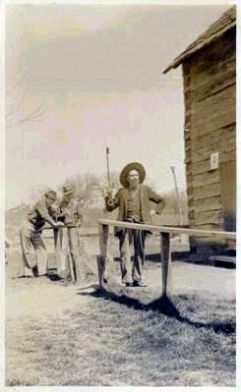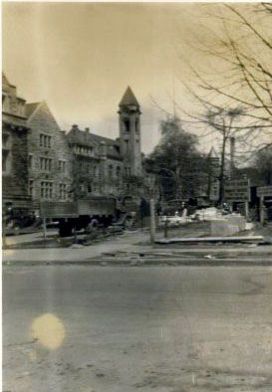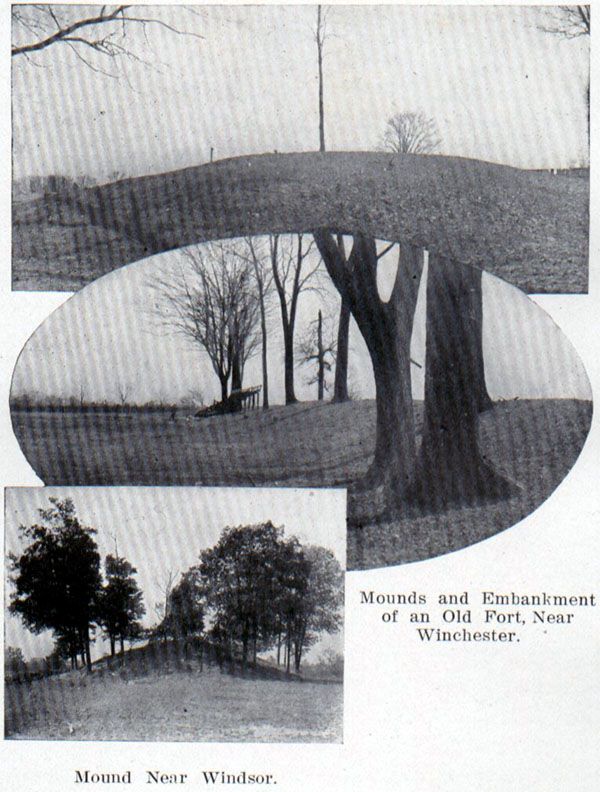Randolph County, Indiana
Populated Areas
Winchester
Scenes from around Winchester
Contributed by Cindy Vanlandingham
The Times-Gazette
Union City, Indiana-Ohio
Monday, April 17, 1944
----------
Masonic Building Fire Recalls Memories
of First Buildings on North Side
----------
Since no records are available I have had to rely on the memory of some of our old citizens, one of whom is Oscar Puckett, and I will relate to you his story as told to me. By Philip KabelPopulated Areas
Winchester

| 
|  |
Scenes from around Winchester
Contributed by Cindy Vanlandingham
The Times-Gazette
Union City, Indiana-Ohio
Monday, April 17, 1944
----------
Masonic Building Fire Recalls Memories
of First Buildings on North Side
----------
“My earliest remembrance of the north west corner of Main and Washington Streets date back to about 1873, when as a boy of six years of age, I came to town with my father. At that time there was a high board fence along the west side of Main Street, the boards being vertical and fitted so closely together that one could not see what was on the other side of the fence. It must have been at least six feet high and extended northward along the west side of the street for nearly half a block. I remember asking father what was on the other side. He told me that a large log building had once stood there but had burned down.
When we moved to town in March, 1878, the fence had been replaced by a brick building on the corner of the streets named above and extended back north to about the same distance as the present K. of P. building. Just north of this building the fence had been replaced with a frame structure in which George Longnecker had a tailor shop, and many is the time I have seen him sitting cross-legged on the top of a wide table plying his needle and thread, and I wondered how it was possible for anyone to sit in that position and sew.
Just north of the tailor shop the fence had been replaced by another small frame structure which housed Isaiah (Pony) Ryan's barber shop. This shop had quite an attraction for me; prominently displayed was Pony's snare drum which he played in a martial band, and many is the time I stood at his side and watched him make what seemed to me marvelous rolls on it. He finally noted my interest and offered to teach me to play it, thus I received my first music lesson.
Just north of the barber shop was Deacon Harter's livery stable which extended to the alley. Deacon Harter was famous for his long silken beard which extended to his waist-line.
Speaking of long beards, I remember some other men with long beards reaching down to their waist-line, viz: John Heaston, afterwards postmaster, Dr. C. C. Hiatt, Dennis Kelley, and Taylor Semans. There probably were others but these stand out in memory.
Just across the alley north from the Deacon's livery barn, was Billy William's implement shop. Just north of this was a vacant lot on which our baseball pitchers used to practice. This vacant lot was afterward occupied by an old photographer's car, belonging to Mr. Snedaker. He used to travel from place to place in this car which served for a home and a gallery at the same time. This man afterwards built the Snedaker block on the site now occupied by the Randolph County Sales company. The second floor was fitted up with a stage and seats and was frequently used for ten-cent comedy companies and medicine shows.
The south west corner of Main and North Streets was occupied by Sol Junker's residence. It occupied the whole of the ground where the I. O. O. F. building and the rooms just south of this building now stand, and extended to the old photograph car I have just mentioned. The old Junker home was moved to the west side of North Main street in the Five Hundred block. It was torn down a few years ago to make room for more modern residences.
The brick building which replaced the board fence on the north west corner of Main and Washington Streets was occupied for many years by Kent Brown's barber shop. In this shop were at least six barber chairs, with Burrel Thompson working on the first chair and Kent operating the last one. I well remember the giant cup-case on the east wall. It was quite the thing those days for the patrons of barbers to have their own shaving mugs and brushes; this was the reason for the great pigeon-holed case. These shaving mugs were generally very elaborately decorated affairs with the owner's name enameled on each one. This was much the largest barber shop Winchester ever had I suspect. Old residents of Winchester will remember Kent Brown's tragic death in the early nineties.
On the next lot west from Brown's barber shop was James Moorman's bank, a three-story brick building. Its two-sashed small paned windows, made it, to my childish mind, quite a gloomy place. James Moorman was a member of the Society of Friends, and regular attender of the old Friends' Meeting Housed which stood on the site of the present Friends' Church. He always sat on the dais at the south end of the church with the other ministers and elders and wore his stove-pipe hat through the entire service except during prayer. He accumulated great wealth; before the Civil War, his wealth, according to Prof. Ebenezer Tucker's History of Randolph County was reckoned by the tax authorities at about $265,000.00. His quaint expression, ?I'd a leetle rather, not,” became very near to being a classic about Winchester at that time. Some sacrilegious sinner is said to have interpreted it as “I”ll be damned if I will.” However, James Moorman loved children, and the James Moorman Orphans' Home stands as a monument to this love.
Just west from the bank stood a small frame building erected by young Robert J. Litschert to house his jewelry and watch repair shop. Young Bob, as he was called, was a skilled, quiet spoken artisan who soon climbed up in the financial world and became one of the leading business men of Winchester.
On west of the Litschert establishment was another section of board fence, built tight and hight, but which about 1880 was torn down and a little shack was built to accommodate a little confectionery store. This little store was operated by two young fellows, one of whom was “Grassy” Lennon; I do not remember the name of his partner, nor do I know what became of “Grassy.”
The next room to the westward was a two-storied frame building, the lower floor of which was occupied by Mrs. McClusky's hair shop. Her show windows were filled with switches and curls for women. I don't suppose any of the younger women of our day know what a switch is. My mother used to save the combings of her hair and when she had accumulated a large quantity of it she took it to Mrs. McClusky who, by some kind of art combined with patience, would straighten out the hair and weave it onto a cord. This strand of hair my mother would fasten with her other hair and then do it up on the back of her head, thus, by means of the switch, increase the size of the roll on the back of her head. This roll was usually set off with a large comb about three inches wide and projecting upward high enough to be seen over the top of the head. The false curls were made from combings also and were worn hanging down each side of the face. So, you see, our grandmothers were romantically inclined, with their switches, curls, hoop-skirts, bustles, and shoes that either laced up the side or buttoned. Some wag has carried this idea of romanticism still farther when he said, “just think what our grandmothers had to put up with; when they were kissed, there was the walrus moustache and a chewing tobacco scented breath to endure.” Anyway, Mrs. McClusky must have been a progressive woman, even if she didn't use lipstick or paint her fingernails.
The second floor of this building housed Johnny Chapman's harness shop. Johnny was a little man, barely five feet tall. At that time the County Fair was in the heyday of its existence and Johnny became interested in racing stock and moved to Labette county, Kansas. As I remember, Mart Miller worked for him as a harnessmaker. Another man also was employed by him, but I do not remember his name. He had a withered leg and walked with a single crutch.
As I remember it now, the next room west of the Hair Shop was Riley Hiatt's Hardware store. This man, Riley Hiatt, was noted for his honesty and square dealing. A common mode of comparison was, “as honest as Riley Hiatt.” He and Thomas Ward, Sr., were fast friends and Mr. Ward spent a lot of his spare time in Mr. Hiatt's store. In fact, Mr. Ward had many business interests and his headquarters were in the Hiatt store. Just to the west of the Hiatt store was the broad stairway that led up into the City Hall, as it was called. Most of the shows that came to town exhibited their wares there; here were held also the high school commencements.
The Magee Stove store came next. This was primarily a stove store but C. E. Magee also had a tin shop in connection with it. Here for several years were employed Lambertine Irvin and Al (Gooner) Fletcher, a brother of James M. (Buck) Fletcher. Gooner was an ardent baseball enthusiast and caught behind the home-plate in the days before masks and gloves were in use.
In later years, Mr. Magee enlarged his business to include a general line of hardware, and the establishment is still know as the Magee Hardware company.
At this time the courthouse was new and was said to be the most beautiful structure of its kind in the state. I remember that the Harvey Geography which was used in the Winchester schools at that time, had an Indiana supplement in the back of it consisting of several pages, made special mention of our courthouse and its beautiful tower.”
For some time the ground just east of the Masonic building was vacant, and on this Billie Reinheimer, father of George Reinheimer, built a small frame building in which he had his shoe repair shop, a large window forming a big part of the south end or front.
One evening some mischievous boys placed a brick on the walk in front of the building and covered it with an old hat, hoping that some one would come along and kick the hat and stub his toe on the brick. They had not long to wait until a prominent citizen accompanied by his good wife came along.
She could not resist the temptation to see how far she could kick the old hat, and with a powerful swing of her right foot she let go as if trying to kick the extra point after a touchdown, nearly breaking her toes on impact with the brick.
So infuriated was the husband that he picked the brick up and hurled it through the large window thinking that the culprits were on the inside watching, and hoping to raise a bump on some fellow's head.
So prolific was he in his use of choice words that for a short time a blue cloud settled over the place.
The next morning, soon after Billie had come to the shop to begin his day's work, the prominent citizen came in and explained to him the occasion for the broken window and then ordered a new one put in at his own expense.
Under the outside stairway on the east side of the barbershop one of our ex-county officials, when a boy, had what he says was one of the most successful fights he ever had. When it was over both participants had black eyes, swollen lips, and one of the fellows had two or three teeth jarred loose. He says it was a humdinger and was called a draw.
After it was over they shook hands and made up, and were close friends and companions until the other fellow moved away from Winchester.

1907 Newspaper

Geodetic Marker Populated Areas Index Main Randolph County Page
| The Randolph County, Indiana INGenWeb family history site is maintained by Phyllis Fleming. Copying is permitted for noncommercial, educational use by individual scholars and libraries. You may link to this page with prior permission, provided no fee is required to access the link, but no commercial use of this material is permitted. This message must appear on all copied material. |